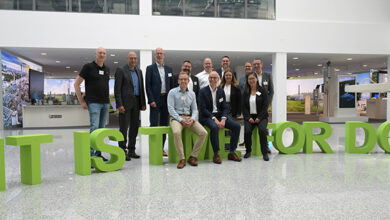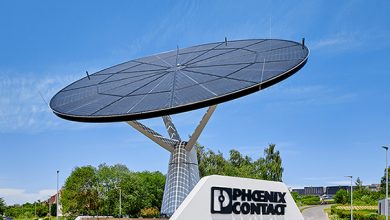Sometimes the sun shines, sometimes clouds darken the day. And the solar panels. Sometimes the wind blows, sometimes it’s calm. And the wind turbines stand still. Our power grids have to withstand these fluctuations in renewable energy. The All Electric Society Park shows what it takes.
Almost every door in the All Electric Society Park is open to visitors. But right in the middle of the park is an eye-catching cube whose doors are deliberately kept firmly closed. Nevertheless, it reveals its interior, as large glass surfaces allow a view of the central transformer station with its medium and low voltage distribution. But it is strictly forbidden to enter, as the voltage here is high. Cheeky visitors could inadvertently become lightning conductors with fatal consequences.
Open-hearted with a safety guarantee
With this knowledge, you look at the functional building with completely new eyes. Admittedly: Action looks different. Nothing turns here, and apart from a few LEDs, there is no light show. But for the expert in charge, this is the ideal situation. “This transformer station is something very special, because the glass surfaces have to withstand extreme energies that want to get out from the inside in the event of major faults.” Andreas Flandermeier is responsible for the housing and interior of the central power distributor.
Phoenix Contact has its own 30 kV ring feeder across the company premises to supply its production facilities. The electrical energy from this ring is distributed by more than 20 transformer stations, almost as many as can be found in the entire city of Blomberg. Certainly the most impressive of these pacemakers of the electrical supply is located directly in the All Electric Society Park. Andreas Flandermeier was the project manager for this special transformer station: “The ring feeder runs directly under the park and the Cube. Both the medium and low-voltage switchgear and the two green transformers are housed in the vertically planted cube and are visible through the glass pane.”
Airhead

Details inside show how carefully the issue of sustainability has been considered here: The medium-voltage switchgear is made up of four sections, the so-called switch panels. They connect the station with the 30 kV company network and the two transformers. Air was deliberately used as the insulating medium for the medium-voltage switchgear instead of the usual gas insulation. A system that uses the climate-damaging insulating gas SF6 would be much more compact. However, SF6 is 23,000 times more harmful to the climate than CO2 if it is released due to a fault.
A unique cube
The low-voltage switchgear, which is also housed in the switch room, takes over the contactor of the individual consumers and generators in the All Electric Society Park. Each outgoing cable is equipped with its own energy meter. The station is connected via fiber optic cable to the control center in the pavilion, where all data is recorded, right up to the opening of the door.
The larger of the two green transformers supplies the All Electric Society Park with power from the ring feeder. The smaller one connects a 1.1 MWh battery storage system. The transformers are cooled by a synthetic ester. This is biodegradable and replaces the mineral oil that is normally used.






“Transformer houses are actually nothing special. But this green cube is unique and will remain so,” says the 46-year-old electrical engineer and project manager with pride. “Together with the experts from the company Gritec from Baden-Württemberg, we have created a prototype that is full of innovations. It starts with the base material. Normal transformer stations consist of stable reinforced concrete walls. Our station is also stable, but it weighs much less. Because carbon concrete is used here.”
Instead of the usual steel reinforcement, carbon fiber mats reinforce the concrete and provide the required tensile strength. This made it possible to reduce the wall thickness of the transformer station from 14 centimetres to eight centimetres, saving more than 15 tons of concrete. Less concrete means less cement. And less cement is therefore a significant factor in reducing the station’s CO2 footprint due to its enormously energy-intensive production.
12.2 minutes blackout
Andreas Flandermeier spans the arc from the decorative transformer station to the general energy revolution: “With the technologies used here, we monitor the condition of the low and medium-voltage system in real time. The data obtained can be used for long-term grid planning and maintenance as well as for daily operation. The transmission of measured values in real time enables the digital recording of the condition of the medium and low-voltage grids. Whereas in the past, maximum current measurement in the distribution grid provided information about the maximum load in a year using a drag indicator, meaningful load profiles can now be created using remote control technology. These form the basis for targeted grid expansion at the points where it is really needed. Digitalization creates the necessary transparency and overview of all stations in the distribution grid. Faults can be quickly identified and addressed remotely. With remote switching, faulty grid sections can be isolated and switched off. This increases the quality of supply, whether for private households or industrial companies. After all, we only had 12.2 minutes of power outage per end consumer in Germany in the whole of 2022. That is an international record that we definitely want to maintain, despite the expansion of renewable energy sources.”
The transformer station
Eight percent of global carbon dioxide emissions are caused by cement as a building material. Carbon concrete was used in the transformer station at the All Electric Society Park, saving 15 tons of material alone. The transformers are cooled with biodegradable Esther instead of the usual mineral oil. And they are insulated with air instead of the extremely climate-damaging insulating gas SF6.
Facts
- 2 green transformers make contact with the ring feeder and the battery storage system
- 590 kilograms of CO2 are released during the production of one ton of cement
Der All Electric Society Park
Phoenix Contact Intelligente Ortsnetzstationen
Betonbau gmbH / Gritec







